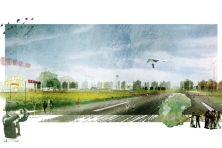Fasten Your Seat Belt
Kaufbeuren (DE) – Winner
TEAM DATA
Team Representative: Ana Quintana Zazurca (ES) – architect; Associates: Sergio Romero Moreno (ES), Giorgia Sgarbossa (IT) – architects; Elisenda Lurbes Soriano (ES) – landscape engineer
Nou de Sadurni 9, 2º 4ª, 08001 Barcelona – España
+34 699 95 59 70 - ana.quintana.zazurca@gmail.com
See the complete listing of portraits here
See the site page here

E. Lurbes Soriano, S. Romero Moreno, G. Sgarbossa and A. Quintana Zazurca
INTERVIEW
1. How did you form the team for the competition?
We met at the Barcelona School of Architecture where we started to work in close collaboration in 2011. Each of us has a different background and contributes to the projects with a complementary approach.
2. How do you define the main issue of your project, insisting on how you answered on this session main topic: adaptability and urban rhythms?
Our proposal foresees the organization of a complex development with clear functions and multiple open scenarios; the main issue of our project is the way the architecture and the landscape interact with each other at the territorial scale and open a new relationship and new rhythms with the city. For us the coexistence between different actors at the urban scale is very important: urban farming, research centre, production of energy and flexible living styles. Moreover, the project looks for adaptability while conserving the identity of the old military airbase exploiting the main lines of its layout.



3. How did this issue and the questions raised by the site mutation meet?
We think the airbase is an interruption in the natural fabric of this part of the Swabian landscape: it cuts across the green belt obstructing a natural corridor. This proposal aims to solve the disconnection with the old town, giving new value to the existing old walls and existing main buildings. The development will be included inside a time process of phases and the architectural structures will be in a variety of types planned to meet the town’s changing needs.
For us, introducing productivity issues in development is essential. The new urban planning energy requirements and a productive landscape interact with each other: generation of electricity and water, productive urban farming areas, new and shaped woodland plantations completing the existing forest and establishing a strong connection with the surrounding ecosystem matrix.


4. Have you already treated this issue previously and could you present some reference projects that inspired yours?
Yes, we have worked in research projects on the topic of landscape recovery through cultural and energy transformations using obsolete infrastructures as new urban nodes of activity with the specificity of each site. Our reference projects background is based on an open discussion about recovery and self-sufficient systems. As reference projects we think about the Landshaftpark Duisburg Nord by Peter Latz and the Qinhuangdao Red Ribbon Park by Turenscape. These projects revitalize the industrial landscapes and interpret the existing fragments with a new syntax.
5. Today –within the era of an economic crisis and sustainability– the urban-architectural project should reconsider its production method in time; how did you integrate this issue in your project?
This issue is integrated in the project process based on three principal goals: flexibility, sustainability and adaptability. Architects, planners and landscape architects should wisely work in that sense. We develop a self-sustainable system composed of new housing plus public buildings, urban farms and energy captors. Each unit can be built up in different phases maintaining the identity of the project in dialogue with the city needs.
6. Is it the first time you have been awarded a prize at Europan? How could this help you in your professional career?
Yes, this is our first Europan and this result represents an extraordinary recognition for our team. This prize is a fulfilment for our professional’s career as well as a motivation and a challenge to keep going on.